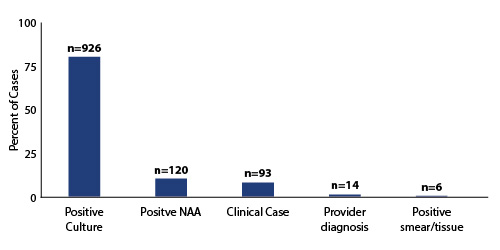Epi Profile Section 4 - Case Diagnosis
Figure 3. Tuberculosis Cases by Diagnostic Method in Texas, 2019

Figure 3 shows that in 2019, most of the TB cases were diagnosed by a positive culture (79.9%). The rest were diagnosed as a clinical case (10.35%), by provider diagnosis (8.02%), by a positive nucleic acid amplification (NAA) test (1.21%), and by a positive AFB smear/tissue only (0.52%). The Centers for Disease Control and Prevention (CDC) Division of TB Elimination defines a clinical case as a TB case that is not confirmed by a positive culture or NAA test but has a positive tuberculin skin test (TST) or a positive interferon gamma release assay (IGRA) for M. tuberculosis complex, signs and symptoms compatible with TB, is on treatment with two or more anti-TB medications, and completed a diagnostic evaluation. A case by provider diagnosis is when a physician diagnoses a person to have active TB, when the criteria for a laboratory confirmed or a clinical case are not met.[1]
1. Centers for Disease Control and Prevention (CDC). Report of Verified Case of Tuberculosis Instruction Manual, 2009. Atlanta, GA: US Department of Health and Human Services, CDC; 2019.
Table of Contents | An Overview of Tuberculosis in Texas | Geographic Distribution of Tuberculosis in Texas | Affected Populations | Case Diagnosis | Recent Transmission | Mortality | Risk Factors Associated with Tuberculosis | Drug Resistant TB | Public Health Follow-Up Outcomes | Reporting Requirements | References